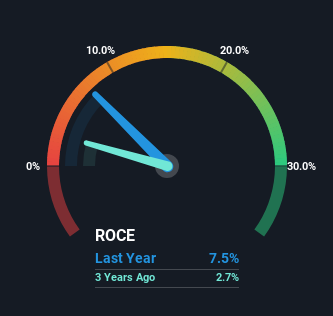Investors Could Be Concerned With Genting Singapore's (SGX:G13) Returns On Capital
What financial metrics can indicate to us that a company is maturing or even in decline? When we see a declining return on capital employed (ROCE) in conjunction with a declining base of capital employed, that's often how a mature business shows signs of aging. This indicates to us that the business is not only shrinking the size of its net assets, but its returns are falling as well. In light of that, from a first glance at Genting Singapore (SGX:G13), we've spotted some signs that it could be struggling, so let's investigate.
Understanding Return On Capital Employed (ROCE)
If you haven't worked with ROCE before, it measures the 'return' (pre-tax profit) a company generates from capital employed in its business. The formula for this calculation on Genting Singapore is:
Return on Capital Employed = Earnings Before Interest and Tax (EBIT) ÷ (Total Assets - Current Liabilities)
0.075 = S$617m ÷ (S$8.9b - S$626m) (Based on the trailing twelve months to June 2023).
Thus, Genting Singapore has an ROCE of 7.5%. In absolute terms, that's a low return, but it's much better than the Hospitality industry average of 3.9%.
See our latest analysis for Genting Singapore
Above you can see how the current ROCE for Genting Singapore compares to its prior returns on capital, but there's only so much you can tell from the past. If you'd like, you can check out the forecasts from the analysts covering Genting Singapore here for free.
What The Trend Of ROCE Can Tell Us
We are a bit worried about the trend of returns on capital at Genting Singapore. About five years ago, returns on capital were 9.7%, however they're now substantially lower than that as we saw above. On top of that, it's worth noting that the amount of capital employed within the business has remained relatively steady. This combination can be indicative of a mature business that still has areas to deploy capital, but the returns received aren't as high due potentially to new competition or smaller margins. If these trends continue, we wouldn't expect Genting Singapore to turn into a multi-bagger.
Our Take On Genting Singapore's ROCE
In summary, it's unfortunate that Genting Singapore is generating lower returns from the same amount of capital. In spite of that, the stock has delivered a 4.6% return to shareholders who held over the last five years. Regardless, we don't like the trends as they are and if they persist, we think you might find better investments elsewhere.
One more thing to note, we've identified 1 warning sign with Genting Singapore and understanding it should be part of your investment process.
While Genting Singapore may not currently earn the highest returns, we've compiled a list of companies that currently earn more than 25% return on equity. Check out this free list here.
Have feedback on this article? Concerned about the content? Get in touch with us directly. Alternatively, email editorial-team (at) simplywallst.com.
This article by Simply Wall St is general in nature. We provide commentary based on historical data and analyst forecasts only using an unbiased methodology and our articles are not intended to be financial advice. It does not constitute a recommendation to buy or sell any stock, and does not take account of your objectives, or your financial situation. We aim to bring you long-term focused analysis driven by fundamental data. Note that our analysis may not factor in the latest price-sensitive company announcements or qualitative material. Simply Wall St has no position in any stocks mentioned.

